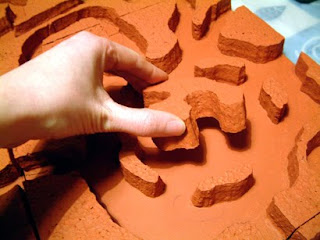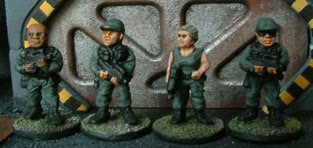Well, the caverns are coming along nicely. Here is a view of the whole lot cut out, stuck down and with the tunnels all widened to the required width. You can see a selection of extra polystyrene bits which can be used to add interest to the tunnels, eg. rockfalls to block tunnels, extra tunnel walls to break up large caves if desired etc.

"What's round this corner - do I hear something breathing heavily...?"
A test for my idea of marking movement spaces onto the tiles. Tunnels will mainly be 1 space wide, but with larger caverns and some wide tunnel sections.
Xenomorph and NAC marine test the tile out...
The tiles after painting the base coat. Although I'll want to work on some shading at a later stage, the tiles look pretty good as they are - the dark matt paint brings out the texture very well.
I have a few loose sections of cavern wall that can be used to divide up larger caverns if desired, so I have a choice of more tunnels, or just a large chamber (a Xenomorph egg chamber perhaps...)
A test piece for painting the movement spaces. This has come out much darker than I intended, so more experimentation is required before I achieve the desired result.
A cavern pool. This was made with paper stuck underneath a hole torn through the cork base sheet. A couple of the cork fragments make stepping stones across the pool. The paper cockled slightly when painted, but this actually adds to the effect, creating an interesting rippled texture. I think a slightly lighter purple may be better. I probably won't create water areas in any of the other tiles I've made so far. I shall leave that for a future project, creating a small set of water caverns to add to this basic set.
I may leave the caverns at this stage for now, concentrating on preparing the figures & rules I need for the Old Buckenham Bone Crushers meeting nect weekend.
TTFN
Paul









 Some basic plans are sketched out whilst watching TV one evening and I’m ready to go.
Some basic plans are sketched out whilst watching TV one evening and I’m ready to go.


























